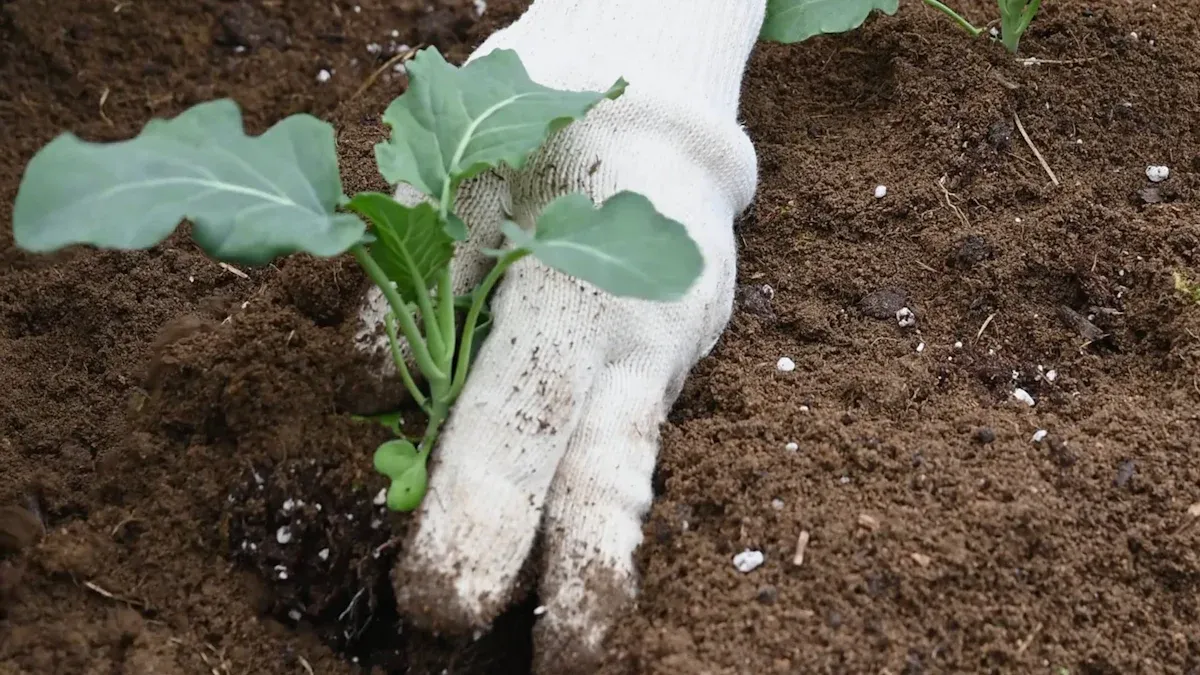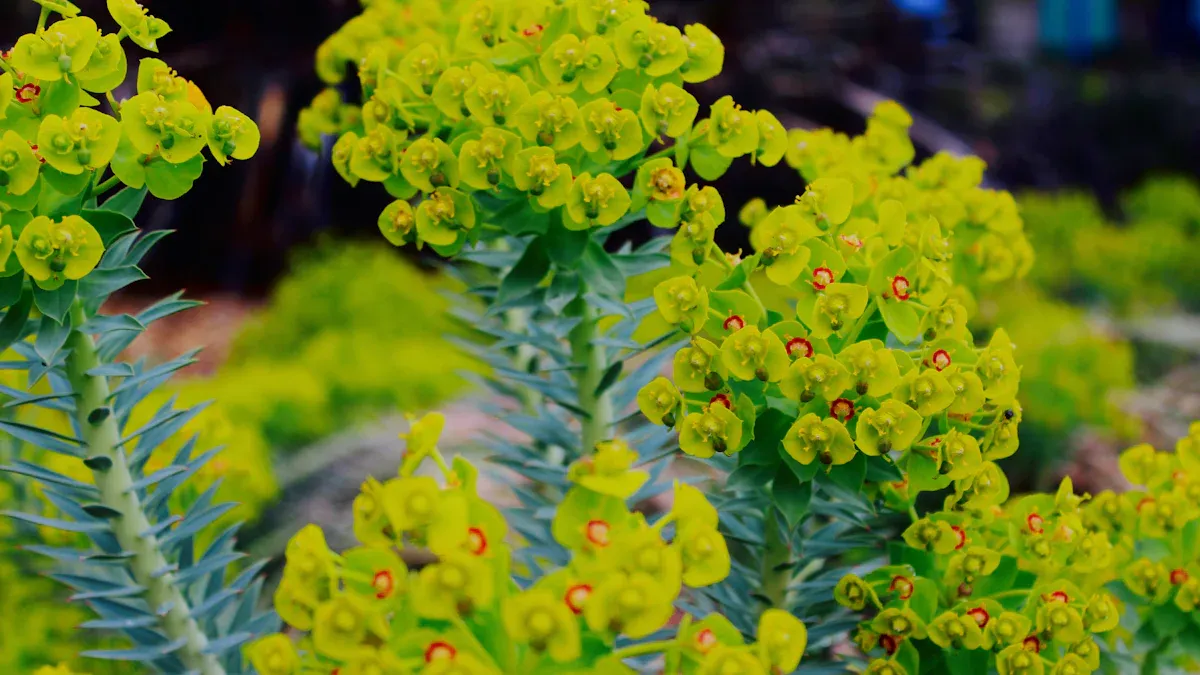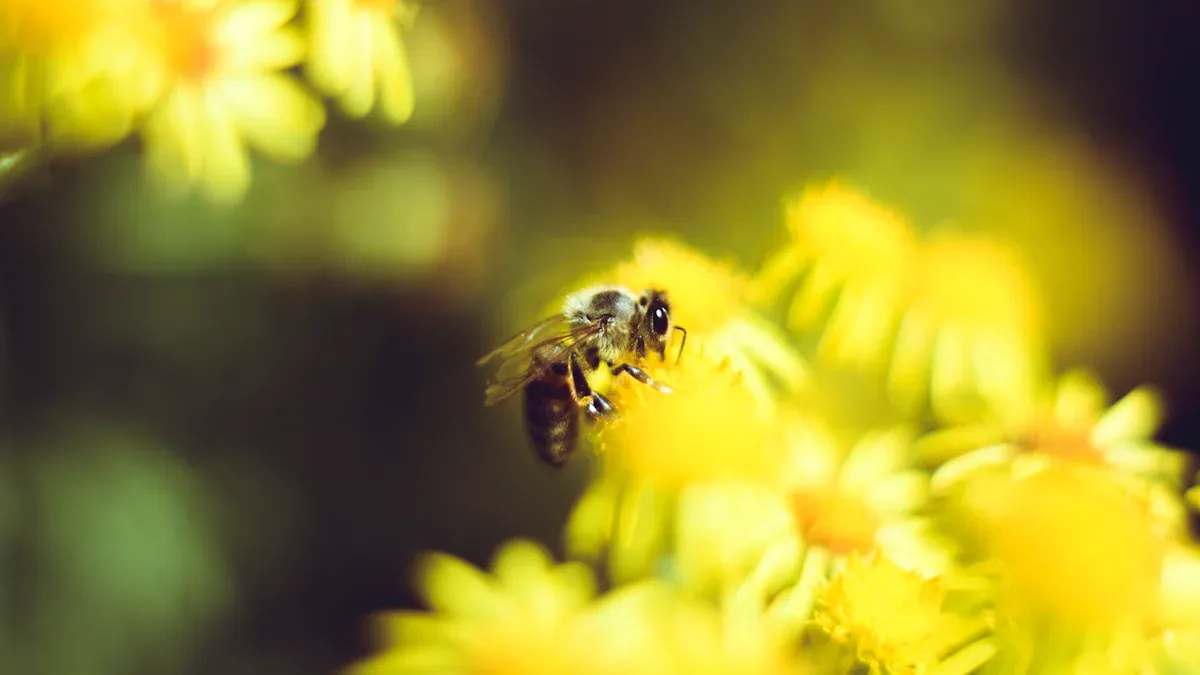
Pollination plays a crucial role in the success of your Euphorbia plants. It can significantly boost your yield, making your garden flourish. Euphorbia species have unique features that make pollination essential. For instance, their complex cyathia structure not only attracts pollinators but also ensures reproductive success. A study found that outcross pollination in Euphorbia fischeriana led to a seed set ratio of about 50%, while artificial self-pollination dropped this to just 36%.
Here’s a quick look at some unique characteristics of Euphorbia that highlight why pollination is so important:
Unique Characteristics | Description |
|---|---|
Cyathia Structure | Complex inflorescences that resemble a single flower, including male and female flowers and nectar glands to attract pollinators. |
Timing Preferences | Some species produce nectar at specific times to attract particular pollinators. |
Nectar Protection | Use of sticky substances or mechanical structures to protect nectar from unwanted visitors. |
Mimicry and Attraction | Some cyathia mimic other flowers or emit scents to attract insects. |
Understanding these aspects can help you effectively pollinate Euphorbia plants.
Key Takeaways
Pollination is crucial for Euphorbia plants. It significantly boosts yield and ensures successful reproduction.
Understanding male and female flower differences helps in effective pollination. Male flowers attract more pollinators with nectar.
Timing is key. Pollinate during peak blooming hours to maximize seed set and ensure male and female flowers bloom together.
Create a pollinator-friendly garden. Group Euphorbia with other flowering plants to attract bees, butterflies, and other pollinators.
Self-pollination can enhance yield. It reduces reliance on external pollinators and maintains plant traits, but be mindful of genetic diversity.
Euphorbia Inflorescence

Male and Female Flowers
Euphorbia plants have a fascinating structure when it comes to their flowers. They can be dioecious, meaning you’ll find separate male and female flowers on different plants. This unique feature is crucial for effective pollination. Here’s a quick look at the differences between male and female Euphorbia flowers:
Aspect | Male Flowers | Female Flowers |
|---|---|---|
Flower Morphology | Smaller, fewer stamens | Larger, more developed ovaries |
Reproductive Function | Higher pollen production | Limited to ovule production |
Resource Allocation | Resource exhaustion at distal levels | More resources allocated to ovaries |
Nectar Secretion | Higher rate in male cyathia | Lower or absent in female cyathia |
Pollinator Attraction | Attracts more visits due to nectar | Fewer visits needed for ovule success |
Understanding these differences helps you appreciate the role each flower type plays in pollination. Male flowers produce more nectar, attracting various pollinators like bees and butterflies. In contrast, female flowers focus on developing seeds, requiring fewer visits from pollinators.
Flowering Periods
The flowering periods of Euphorbia plants can vary widely depending on the species. Some bloom in spring, while others may flower in summer or fall. Knowing when your Euphorbia flowers will bloom is essential for successful pollination.
To maximize your yield, keep an eye on the flowering times. You want to ensure that male and female flowers are blooming simultaneously. This synchronization increases the chances of successful pollination. If you notice that your plants are out of sync, consider planting different species that flower at the same time. This way, you can create a more pollinator-friendly environment in your garden.
By understanding the intricacies of Euphorbia inflorescence, you can take steps to enhance pollination and boost your yield.
Pollinators and Their Role

Pollinators play a vital role in the life cycle of Euphorbia plants. They help transfer pollen from male flowers to female flowers, which is essential for seed production. Without these pollinators, your Euphorbia plants may struggle to reproduce effectively.
Insects as Pollinators
Insects are the primary pollinators for many Euphorbia species. Recent studies show that various insects contribute to this process. For example, in Euphorbia verrucosa, sawflies from the genus Tenthredo are significant pollinators. Ants also visit many Euphorbia species, although their effectiveness as pollinators is still being studied. Interestingly, some Euphorbia species, like Euphorbia peplus and Euphorbia dulcis, can reproduce without insect pollination. However, showy species like Euphorbia virgata rely heavily on pollinators for successful seed production.
Here’s a quick overview of some common insect pollinators you might find visiting your Euphorbia plants:
Pollinator Type | Description |
|---|---|
Bees | Attracted by the nectar and bright colors of Euphorbia flowers. They are essential for many species. |
Butterflies | Drawn to the sweet scent of the flowers, they help in transferring pollen as they feed. |
Moths | Active at night, these pollinators can also contribute to the pollination of certain Euphorbia species. |
Other Pollinators
While insects are the most common pollinators, other creatures also play a role. Birds and even some mammals can assist in pollination. For instance, the Balearic lizard (Podarcis lilfordi) has been observed pollinating Euphorbia dendroides by transferring pollen while feeding on nectar. This highlights the diverse range of pollinators that can benefit your Euphorbia plants.
To attract these pollinators to your garden, consider the following tips:
Group Euphorbia with other pollinator-friendly plants to create a dedicated garden area for pollinators.
Plant Euphorbia in areas that receive full sun or partial shade, as they thrive in various conditions.
Take advantage of the showy flowers of Euphorbia, which attract bees with their honey-like scent.
By creating a welcoming environment for pollinators, you enhance the chances of successful pollination and, ultimately, a better yield from your Euphorbia plants.
How to Pollinate Euphorbia Plant
Pollinating your Euphorbia plants can be a rewarding experience, especially when you see the fruits of your labor in the form of increased yield. Manual pollination is a straightforward process that can significantly enhance your plants’ reproductive success. Here’s how to do it effectively.
Manual Pollination Steps
To successfully pollinate Euphorbia plants, follow these simple steps:
Identify Male and Female Flower Parts: Start by locating the stamens, which are the male parts, and the pistils, the female parts, on the flower.
Collecting Pollen: Use a small brush or a cotton swab to gently gather pollen from the stamens. This step is crucial for successful pollination.
Transferring Pollen: Carefully apply the collected pollen to the pistils of the same flower or another flower. This transfer is essential for fertilization.
Timing: For the best results, perform hand pollination during peak blooming hours when the flowers are most receptive.
By following these steps, you can effectively pollinate Euphorbia plants and improve your chances of successful pollination.
Timing for Successful Pollination
Timing is everything when it comes to pollination. To maximize seed set in your Euphorbia plants, you should be aware of the different stages of flowering and seed production. Here’s a quick overview:
Stage | Duration |
|---|---|
Flowering Stage | 2-3 months |
Seed Production Phase | 4-6 weeks after flowering |
Make sure to pollinate during the flowering stage, as this is when the flowers are most receptive to pollen. Regularly check your plants to ensure you’re not missing the optimal window for pollination.
By understanding the timing and following the manual pollination steps, you can significantly enhance the yield of your Euphorbia plants. Happy gardening!
Increase Your Yield with Self-Pollination
Self-pollination can be a game-changer for your Euphorbia plants. Understanding how it works can help you maximize your yield. Let’s dive into the mechanisms of self-pollination and the benefits it brings to your garden.
Mechanisms of Self-Pollination
Euphorbia plants have developed several fascinating mechanisms for self-pollination. Here’s a quick overview:
Mechanism | Description |
|---|---|
Self-Incompatibility (SI) | Some species, like Euphorbia boetica, avoid self-pollination to promote genetic diversity. |
Dichogamy | This mechanism involves the timing of male and female phases in flowers, preventing self-fertilization. |
Flowering Synchrony | This ensures that male and female flowers bloom at the same time, allowing for effective self-pollination. |
Experimental Assessments | Studies have evaluated these mechanisms in natural populations, helping us understand their effectiveness. |
These mechanisms help ensure that even if pollinators are scarce, your Euphorbia plants can still reproduce effectively.
Benefits for Gardeners
Self-pollination offers several advantages for gardeners like you. Here are some key benefits:
Reduces pollen wastage: You won’t need to rely on long-distance pollen transport, which can be inefficient.
Conserves plant traits: Offspring maintain the characteristics of the parent plant, ensuring consistency in your garden.
Less effort required: Your plants won’t need to attract pollinators, saving energy for growth and fruit production.
Consistent harvest quality: Self-pollinating crops often yield reliable results, similar to beans and peas.
However, keep in mind that self-pollination can also reduce genetic diversity. This loss can make your plants more vulnerable to diseases and environmental changes. For example, the kiwifruit industry in New Zealand faced significant challenges due to limited genetic variety, which hindered adaptation to bacterial infections.
By understanding self-pollination, you can take steps to increase your yield while being mindful of the potential downsides. Embrace these techniques to enhance your gardening success!
In summary, effective pollination is vital for boosting the yield of your Euphorbia plants. By understanding the unique structure of their flowers and the role of various pollinators, you can enhance your gardening success. Remember, the right techniques can lead to impressive results. For instance, studies show that a higher pollen load can significantly increase seed set and seed mass.
However, challenges like environmental factors and declining pollinator populations can hinder your efforts. To overcome these, consider using protective measures and enhancing pollinator habitats. By applying these tips, you’ll not only improve your Euphorbia yield but also contribute to a healthier ecosystem. Happy gardening!
FAQ
What is the best time to pollinate Euphorbia plants?
Pollinate your Euphorbia plants during peak blooming hours, usually in the morning. This is when flowers are most receptive to pollen, increasing your chances of successful fertilization.
How can I tell if my Euphorbia is self-pollinating?
Look for flowers that produce both male and female parts. If you notice that the flowers can set seeds without external pollinators, your Euphorbia likely has self-pollinating capabilities.
Do I need to use special tools for manual pollination?
You don’t need fancy tools! A small brush or cotton swab works perfectly for collecting and transferring pollen. Just be gentle to avoid damaging the flowers.
How often should I pollinate my Euphorbia plants?
Pollinate your Euphorbia plants every few days during their flowering period. Regular pollination increases the chances of successful seed set and boosts your overall yield.
Can I attract more pollinators to my garden?
Absolutely! Plant a variety of flowering plants alongside your Euphorbia. Bright colors and sweet scents will draw in bees, butterflies, and other beneficial insects, enhancing pollination. 🌼

